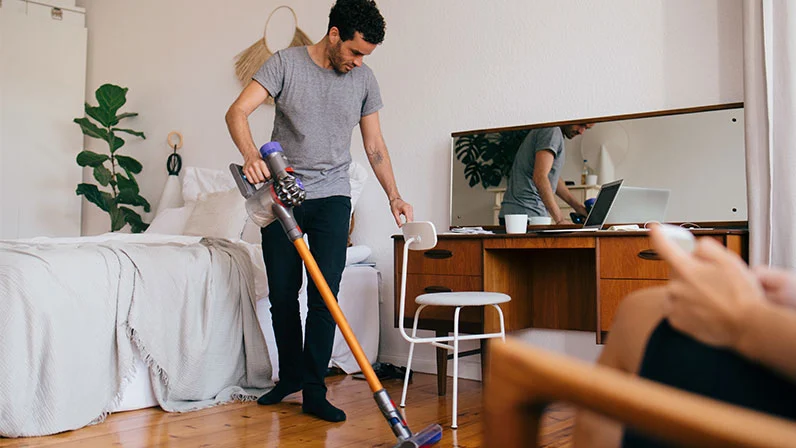All About Dust Mite Allergies
What are the symptoms of a dust mite allergy?
If you suffer from dust allergies, you already know about the sneezing, runny nose, and watery eyes that impact your everyday life. The primary cause of indoor dust allergies is the presence of dust mites. These nasty little creatures feed off the everyday dust and skin cells shed by people and found in most homes.1 A dust allergy can make being indoors almost unbearable.
What is dust made of?
This may fall into the category of questions you don’t want to know the answer to, but here is the not-sopretty truth: household dust is made up of dust mites, hair, dead skin cells, mould, small insects and lots more icky stuff.2 With many of these particles hidden to the naked eye 2, they can be widely spread on the various surfaces of your home including floors, sofas and beds.
Where does dust come from?
The short answer is that dust comes from both inside and outside your house.4 Pollen and other airborne particles enter the house when you do. They can also get in when you open a window. Particles get on your clothes and shoes, which bring these unwelcome visitors inside.
Things get a little bit more complicated when you take a closer look at indoor dust. Carpeting, upholstered furniture, pillows, and bedding are all made up of fibres. When these fibres start to decay, particles enter the air and contribute to the dust in our homes. Now comes the part no one really wants to talk about. Specifically, the "other stuff" that makes up the household dust. Pet dander, pollen, clothes fibres and a lovely mixture of other insects or bugs often contribute to what we call dust.3
How to get rid of dust mites
Don’t worry, it’s not all doom and gloom. There are lots of easy, everyday things you can do to greatly reduce the amount of dust in your home. Some easy ways to do this include:
- Increasing the flow of outdoor air
- Using air cleaners with certified asthma and allergy friendly filters
- Vacuuming frequently with certified asthma and allergy friendly filters
If your allergies are flaring up, or you are particularly sensitive to dust, consider wearing a mask while doing your household cleaning. Also keep in mind that while a good-quality vacuum with a clean filter is an excellent weapon in the fight against allergies, the opposite is also true; a poor-quality vacuum can actually put more dust back into the air.
Your furry friends
All cats and dogs — even hairless ones — contain allergens. That's because the source of pet allergies isn't actually in the fur, but in a protein found in a pet's bodily fluids and dander.5 Some dog and cat breeds contain fewer allergens than others, but when you hear that a dog breed is “hypoallergenic” it simply means that they don’t shed as much, so there is less fur for allergens to stick to. No dog breed is truly hypoallergenic or completely allergen free.
If you already have a pet or are looking to make your home a safer place for an allergy sufferer, here are three easy things you can do to greatly reduce pet allergy symptoms:
Designate a room or section of your home as a “pet-free zone.” Keep pets from entering certain rooms and you will greatly reduce the chances of pet dander settling in those areas. You can use air purifiers throughout your home. A good-quality air purifier, with a filter that’s changed often, is a great way to keep clean air circulating throughout your home. Give your pets a bath at least once a week. Not all cats and dogs love bath time, but they’ll get used to it. You should also make sure to use shampoo that is specifically designed for your kitten, puppy, cat, or dog.
.jpg 400w,/.imaging/webp/sanofi-chc/img-w500/dam/allevia/homepage/understanding-hay-fever/hayfever/ART6-banner-815x815--1-.jpg/jcr:content/ART6-banner-815x815%20(1).jpg 500w,/.imaging/webp/sanofi-chc/img-w600/dam/allevia/homepage/understanding-hay-fever/hayfever/ART6-banner-815x815--1-.jpg/jcr:content/ART6-banner-815x815%20(1).jpg 600w,/.imaging/webp/sanofi-chc/img-w700/dam/allevia/homepage/understanding-hay-fever/hayfever/ART6-banner-815x815--1-.jpg/jcr:content/ART6-banner-815x815%20(1).jpg 700w,/.imaging/webp/sanofi-chc/img-w800/dam/allevia/homepage/understanding-hay-fever/hayfever/ART6-banner-815x815--1-.jpg/jcr:content/ART6-banner-815x815%20(1).jpg 800w)
Allevia® is here to help fight dust allergies
Take Allevia before your allergy symptoms take over you.
Life isn’t waiting for your allergy symptoms to pass and neither should you.
That’s why Allevia® helps deliver relief that lasts 24 hours, acts within one hour and is prescription strength, so you can get on with enjoying your day.
Allevia 120mg tablets contain fexofenadine. For the symptomatic relief of allergic rhinitis. Always read the label.
MAT-XU-2304726 (v1.0) December 2023
- Mayo Clinic, Dust Mite Allergy, https://www.mayoclinic.org/diseases-conditions/dust-mites/symptomscauses/syc-20352173 Last accessed July 2023
- Dyson, Global Dust Study, https://www.dyson.co.uk/newsroom/overview/features/march-2021/dustcleaninghabits#:~:text=Household%20dust%20is%20a%20complex%20matrix%20of%20components%20that%20can,a nd%20can%20impact%20our%20wellbeing Last accessed July 2023
- BBC Science Focus, What is dust made of? https://www.sciencefocus.com/science/what-is-dust-madeof/ Last accessed July 2023
- National Public Radio, Joe Palca. The Dirt On Dust, National Public Radio https://www.npr.org/2009/11/16/120252957/the-dirt-on-dust (npr.org) (2009)
- Mayo Clinic, James T C Li, M.D., Ph.D. Pet allergy: Symptoms & Causes, https://www.mayoclinic.org/diseases-conditions/pet-allergy/symptoms-causes/syc-20352192 Last accessed August 2023
